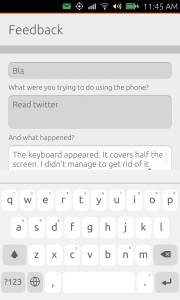Last weekend was my first weekend at FOSDEM! I’m really glad I finally made it there! Apart from a little Friendica developers‘ meeting, I learned how to add a new setting to Friendica, I heard interesting talks and I met old acquaintances as well as new cool people.
And I finally laid my hands on an Ubuntu phone after the talk. I was curious to see it in real life for a very long time. So basically, what I did when I got back was to borrow a partly broken Nexus 4 device to take a closer look. Here are some observations and thoughts of mine:
Getting started
- If you have an Ubuntu computer, the installation routine is great! Compared to all the steps I had to accomplish when I first flashed an Android phone, this is so smooth.
- Once it’s installed, there is a little wizard that guides you through the most important settings and teaches you how to slide (three directions). Then next, you wonder how to get to the „desktop“ / how to see the empty background. Well, no. You always look at an app. You can choose a background image but you’ll only see it before unlocking the screen.
- There is an Ubuntu app store. While on the Ubuntu desktop you can access the software repositories without authentication, the phone wants you to sign in with Ubuntu One. (Which is not exactly a plus, in my opinion.) I admit that I didn’t try to use the command line way before signing in. That remains to be seen.
- The apps you get in there are mostly webapps and these „scope“ thingies where you can include certain platforms into the search function (e.g. soundcloud). I like the feedback app where you can send your experience to Canonical’s Quality Assurance team. (Of course, I tried it. 😉 )
What looks very cool: The nerdy stuff
- The tools that come with Ubuntu’s phablet-tools package! Many developer tools e.g. for packaging, but also: You can take and save screenshots directly onto your computer. You can copy active network connections from the computer to the phone via USB! You can enable ssh and copy over your .bashrc settings file in one go. 🙂
- The shell (though I am still investigating…). I had never really thought about whether Ubuntu phones run an X server. (I had somehow heard about the display server controversy but not followed up.) I had sort of just expected to be able to install stuff from the usual repos with apt. Well… it basically works. I just couldn’t figure out what nice packages are there so far. I randomly tried to find ipcalc, nmap or tree, but they are not available. But still…
user@computer:~ $ phablet-config writable-image
error: closed[… device reboots …]
user@computer:~ $ adb shell
phablet@ubuntu-phablet:~$ sudo apt-get install openssh-server
[sudo] password for phablet:
Reading package lists… Done
Building dependency tree
Reading state information… Done
openssh-server is already the newest version.
0 upgraded, 0 newly installed, 0 to remove and 0 not upgraded.
What’s (still) annoying

- The keyboard’s behaviour (see screenshot): It’s either expanded though you don’t want to edit anything or it hides parts of the input filed you’re typing in.
- The lock screen displays the boring fact that „1 text messages sent today“.
- The prominence of commercial platforms. I understand that this gets Canonical some funding and it’s possible to uninstall things like the amazon app. But still, development seems more driven by closed / commercial services than by free and open ones.
What is missing for my smartphone use cases: Almost everything…
- A PIM app! As you might know, I’m not a GMail user. Apparently, Google is the only service that supports contact synchronization right now. There are web apps for some other email providers but those don’t help me. What is cool about the default Android Email app is that I can connect to my Zarafa server using the MS Exchange account and it works. [Update: Ok, the thing comes with syncevolution so synchronization is possible without Google. Only that there’s no GUI for it and I’m not yet sure it can work with Zarafa’s zsync.]
- A Jabber app with OTR encryption.
- Offline OSM maps!
- An app that lets me connect to all the free and open social networking platforms (Friendica, Gnusocial, Diaspora etc.)
- Comfortable things like an OSM editor, an ownCloud client, a firewall (no doubt this is feasible as I am root on the device).
- Wifi with WPA2 Enterprise encryption.
Preliminary summary
It’s a very cool toy and I want to learn more about it. It’s not for my daily use (yet). Though the developer at FOSDEM said it’s his „production“ phone. What is interesting for me: Looking at this device, I see things that happened to Ubuntu Desktop in a different light. I had been wondering about web apps, all the display server discussion, the Unity desktop (which I don’t use). Some of this makes more sense if they manage to „streamline“ desktop and phone or tablet.